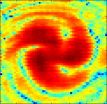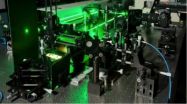(Press-News.org) Building on previous research that twisted light to send data at unheard-of speeds, scientists at USC have developed a similar technique with radiowaves, reaching high speeds without some of the hassles that can go with optical systems.
The researchers, led by electrical engineering professor Alan Willner of the USC Viterbi School of Engineering, reached data transmission rates of 32 gigabits per second across 2.5 meters of free space in a basement lab at USC.
For reference, 32 gigabits per second is fast enough to transmit more than 10 hour-and-a-half-long HD movies in one second and is 30 times faster than LTE wireless.
"Not only is this a way to transmit multiple spatially collocated radio data streams through a single aperture, it is also one of the fastest data transmission via radio waves that has been demonstrated," Willner said.
Faster data transmission rates have been achieved – Willner himself led a team two years ago that twisted light beams to transmit data at a blistering 2.56 terabits per second – but methods to do so rely on light to carry the data.
"The advantage of radio is that it uses wider, more robust beams. Wider beams are better able to cope with obstacles between the transmitter and the receiver, and radio is not as affected by atmospheric turbulence as optics," Willner said.
Willner is the corresponding author of an article about the research that will be published in Nature Communications on Sept. 16. The study's co-lead authors Yan Yan and Guodong Xie are both graduate students at USC Viterbi, and other contributors came from USC, the University of Glasgow, and Tel Aviv University.
To achieve the high transmission rates, the team took a page from Willner's previous work and twisted radio beams together. They passed each beam – which carried its own independent stream of data – through a "spiral phase plate" that twisted each radio beam into a unique and orthogonal DNA-like helical shape. A receiver at the other end of the room then untwisted and recovered the different data streams.
"This technology could have very important applications in ultra-high-speed links for the wireless 'backhaul' that connects base stations of next-generation cellular systems," said Andy Molisch of USC Viterbi. Molisch, whose research focuses on wireless systems, co-designed and co-supervised the study with Willner.
Future research will focus on attempting to extend the transmission's range and capabilities.
INFORMATION:
The work was supported by Intel Labs University Research Office and the DARPA InPho (Information in a Photon) Program.
Scientists twist radio beams to send data
Transmissions reach speeds of 32 gigibits per second
2014-09-16
ELSE PRESS RELEASES FROM THIS DATE:
Kessler Foundation scientists link slowed processing speed with executive deficits in MS
2014-09-16
West Orange, NJ. September 16, 2014. Kessler Foundation researchers have published a study supporting the role of slowed processing speed in the executive deficits found in individuals with multiple sclerosis (MS). "Does slowed processing speed account for executive deficits in multiple sclerosis? Evidence from neuropsychological performance and structural neuroimaging," was published online ahead of print on August 18 by Rehabilitation Psychology The authors are Victoria Leavitt, PhD, of the Manhattan Memory Center, formerly of Kessler Foundation. Co-authors are Foundation ...
Tornadoes occurring earlier in 'Tornado Alley'
2014-09-16
WASHINGTON, D.C. – Peak tornado activity in the central and southern Great Plains of the United States is occurring up to two weeks earlier than it did half a century ago, according to a new study whose findings could help states in "Tornado Alley" better prepare for these violent storms.
Tornado records from Nebraska, Kansas, Oklahoma, and northern Texas – an area of high tornado activity dubbed "Tornado Alley" -- show that peak tornado activity is starting and ending earlier than it did 60 years ago.
Peak tornado activity, which occurs in the region from early ...
Water-based nuclear battery developed by MU can be used to generate electrical energy
2014-09-16
COLUMBIA, Mo. – From cell phones to cars and flashlights, batteries play an important role in everyday life. Scientists and technology companies constantly are seeking ways to improve battery life and efficiency. Now, for the first time using a water-based solution, researchers at the University of Missouri have created a long-lasting and more efficient nuclear battery that could be used for many applications such as a reliable energy source in automobiles and also in complicated applications such as space flight.
"Betavoltaics, a battery technology that generates power ...
Patients waiting too long to see doctor? Try 'just-in-time' management methods, researchers urge
2014-09-16
Using a pain clinic as a testing ground, researchers at Johns Hopkins have shown that a management process first popularized by Toyota in Japan can substantially reduce patient wait times and possibly improve the teaching of interns and residents.
In a report on the pilot study, published online Sept. 9, in Pain Medicine, the researchers adopted the so-called "Just-in-Time" training and inventory process used now by many manufacturers and service industries to stem waste and keep complicated operations from bottlenecking.
"We realized that a significant amount of time ...
Study on global carbon cycle may require reappraisal of climate events in Earth's history
2014-09-16
MIAMI – A recent study of the global carbon cycle offers a new perspective of Earth's climate records through time. Scientists at the University of Miami (UM) Rosenstiel School of Marine and Atmospheric Science suggest that one of the current methods for interpreting ancient changes in the concentration of carbon dioxide in the atmosphere and oceans may need to be re-evaluated.
The UM Rosenstiel School researchers measured the abundance of carbon-12 and carbon-13 isotopes in both the organic matter and carbonate sediments found in a nearly 700-meter marine sediment core ...
UCI team is first to capture motion of single molecule in real time
2014-09-16
Irvine, Calif., Sept. 16, 2014 – UC Irvine chemists have scored a scientific first: capturing moving images of a single molecule as it vibrates, or "breathes," and shifts from one quantum state to another.
The groundbreaking achievement, led by Ara Apkarian, professor of chemistry, and Eric Potma, associate professor of chemistry, opens a window into the strange realm of quantum mechanics – where nanoscopic bits of matter seemingly defy the logic of classical physics.
This could lead to a wide variety of important applications, including lightning-fast quantum computers ...
Making quantum dots glow brighter
2014-09-16
WASHINGTON, D.C., September 16, 2014 – Researchers from the University of Alabama in Huntsville and the University of Oklahoma have found a new way to control the properties of quantum dots, those tiny chunks of semiconductor material that glow different colors depending on their size. Quantum dots, which are so small they start to exhibit atom-like quantum properties, have a wide range of potential applications, from sensors, light-emitting diodes, and solar cells, to fluorescent tags for biomedical imaging and qubits in quantum computing.
A key property of quantum ...
Human faces are so variable because we evolved to look unique
2014-09-16
The amazing variety of human faces – far greater than that of most other animals – is the result of evolutionary pressure to make each of us unique and easily recognizable, according to a new study by University of California, Berkeley, scientists.
Our highly visual social interactions are almost certainly the driver of this evolutionary trend, said behavioral ecologist Michael J. Sheehan, a postdoctoral fellow in UC Berkeley's Museum of Vertebrate Zoology. Many animals use smell or vocalization to identify individuals, making distinctive facial features unimportant, ...
Gene variant that dramatically reduces 'bad' lipids
2014-09-16
Research using data collected from around 4,000 healthy people in the UK has enabled scientists to identify a rare genetic variant that dramatically reduces levels of certain types of lipids in the blood. The study is the first to emerge from the UK10K Project's cohort of samples from the general public and demonstrates the power of whole genome sequencing at scale.
"Until now it has only been possible to look for common variants of small effect in large genome wide association studies," says Dr Nicholas Timpson, first author from the Medical Research Council (MRC) Integrative ...
How learning to talk is in the genes
2014-09-16
Researchers have found evidence that genetic factors may contribute to the development of language during infancy.
Scientists from the Medical Research Council (MRC) Integrative Epidemiology Unit at the University of Bristol worked with colleagues around the world to discover a significant link between genetic changes near the ROBO2 gene and the number of words spoken by children in the early stages of language development.
Children produce words at about 10 to 15 months of age and our range of vocabulary expands as we grow - from around 50 words at 15 to 18 months, ...
LAST 30 PRESS RELEASES:
Jeonbuk National University study shows positive parenting can protect adolescents against self-harm
Surface-engineered ZnO nanocrystals to tackle perfluoroalkyl substance contamination
This new understanding of T cell receptors may improve cancer immunotherapies
A new fossil face sheds light on early migrations of ancient human ancestor
A new immunotherapy approach could work for many types of cancer
A new way to diagnose deadly lung infections and save lives
40 percent of MRI signals do not correspond to actual brain activity
How brain-inspired algorithms could drive down AI energy costs
Gum disease may be linked to plaque buildup in arteries, higher risk of major CVD events
Contrails are a major driver of aviation’s climate impact
Structure of dopamine-releasing neurons relates to the type of circuits they form for smell-processing
Reducing social isolation protects the brain in later life
Keeping the heart healthy increases longevity even after cancer
Young adults commonly mix cannabis with nicotine and tobacco
Comprehensive review illuminates tau protein's dual nature in brain health, disease, and emerging psychiatric connections
Book prepares K-12 leaders for the next public health crisis
Storms in the Southern Ocean mitigates global warming
Seals on the move: Research reveals key data for offshore development and international ecology
Sports injuries sustained during your period might be more severe
World's first successful 2 Tbit/s free-space optical communication using small optical terminals mountable on satellites and HAPS
Can intimate relationships affect your heart? New study says ‘yes’
Scalable and healable gradient textiles for multi‑scenario radiative cooling via bicomponent blow spinning
Research shows informed traders never let a good climate crisis go to waste
Intelligent XGBoost framework enhances asphalt pavement skid resistance assessment
Dual-function biomaterials for postoperative osteosarcoma: Tumor suppression and bone regeneration
New framework reveals where transport emissions concentrate in Singapore
NTP-enhanced lattice oxygen activation in Ce-Co catalysts for low-temperature soot combustion
Synergistic interface engineering in Cu-Zn-Ce catalysts for efficient CO2 hydrogenation to methanol
COVID-19 leaves a lasting mark on the human brain
Scientists use ultrasound to soften and treat cancer tumors without damaging healthy tissue
[Press-News.org] Scientists twist radio beams to send dataTransmissions reach speeds of 32 gigibits per second






